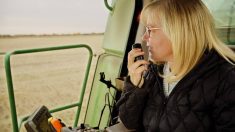In my close to 20 years in farm business consulting, I have worked with many farm families or extended teams. Something I have seen many times is there is not a strong emphasis on building the overall goals for the farm at the same time as trying to meet the needs of the individual members (at least partially). This can lead to confusion and lack of clarity as to what the overall goals for the operation are and how individual needs are met. Thus, I feel that team building and business planning go hand in hand. In this article, I will provide my ideas on how to develop strong farm teams. In the next issue of Grainews, I will offer my ideas on how building strong teams ties into farm business planning.
Read Also

Conagra considers selling its share in Ardent Mills
Conagra is open to selling its 44 per cent share in Ardent Mills, North America’s largest milling company.
Farm teams can come in many different forms — a farming couple, a family unit, or even an extended family with aunts, uncles, cousins and in-laws.
To achieve a cohesive working unit in all of these situations, it is imperative all team members know what the goals for the farm are, and how their individual needs are going to be, at least partially, met. I liken the situation to a team of horses that are all pulling in the same direction. The team can be a small group of two (as stated above) or as many as 12 to 15. The larger the team, the more important it is that all members are “on board” and pulling their weight. Team building should be one of the basic techniques on the farm.
The first principle of team building is this — people will support what they help to build. If you have input on a plan and have developed and fine-tuned it with the input of others, you will feel you have contributed, have been heard and feel responsible for the success of the plan.
The second principle is people will resent what is forced upon them. For example, if someone tells you how to do a certain part of a project in which you have had no input, you will likely feel disinterested in the overall plan — you might even have some resentment toward it and not do your best to make it successful. Therefore, rather than “bossing” your team members around, listen to them and do your best to address their ideas and concerns.
How should team building start? It all starts with good communication, as we’ve heard many times. A good way to begin is to have a family meal first, ideally one that Mom doesn’t have to cook (i.e. one that is catered) to make everyone comfortable. I often get questions about who should be on the farm team. Of course, it should be adult family members and older teens, if they are showing some responsibility and are interested in the business.
In fact, involving older teens might be a stepping stone to succession. My suggestion regarding daughters- or sons-in-law is they be invited to the table since they are members of the extended family and, thus, should be included. I’m afraid if they are not included, marital problems might ensue. Everyone should understand these discussions are completely confidential and not to be shared outside of the people at the table. And the people at the table should understand if anyone breaks that trust, they will be excluded from future meetings.
Before the meeting begins, ask all farm members to bring answers to the following questions to the table:
- What do you like about living and working on this farm?
- What would you change if you could, and how?
- What will you contribute to this farm and help to make it successful?
- What income and perks (e.g. free farm fuel) do you expect?
- What vacation time and other time off do you expect?
- What annual commitment will you make for self-improvement, such as taking courses, attending seminars, etc., at the farm’s expense?
At the meeting, have each person read out their responses to the questions one at a time, then start sharing the various responses. Compromises will almost certainly have to be made to arrive at a total farm plan. That, in turn, can lead to developing values, missions and goals statements for the farm.
Here is an example of a consensus-building scenario:
- Dad would like a new combine costing about $800,000, and with his trade-in would require $500,000 to be financed.
- Mom is tired of living in the 75-year-old farmhouse, which is cold and drafty and doesn’t have modern fixtures and finishes. A rough cost estimate is $400,000.
- The kids want a trip to the mountains to go skiing in the winter for a week during spring break. The cost estimate for new equipment and other associated expenses is $5,000.
It’s not likely that all of these desires can be accommodated in one year, so the following are suggested compromises:
- Could Dad make do with the existing combine for a few more years? The team could examine the feasibility of a newer one in, perhaps, three years’ time.
- Could Mom be somewhat happy with new kitchen cupboards and new windows for an estimated cost of $50,000?
- Will the kids settle for used ski equipment and day trips to a local ski hill for an estimated cost of $1,000?
As we see in the above example, each team member has had input and has had to curb their original wants to achieve an overall consensus that, hopefully, all involved can accept. That is the true value and result of team building.
In the next article, I will show how team building can be a stepping stone to developing farm business plans.
















